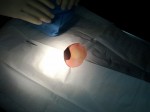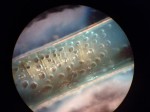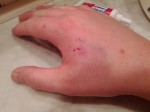From March 2005 to March 2012 I had a 2mm by 12mm glass encased HITAG S tag implanted in my right hand. The HITAG was chosen for it’s feature set, which includes writable memory blocks, the ability to emulate EM4102 tags, and a 40 bit crypto-security feature that could help protect the tag’s memory blocks as well as the communication session with the reader itself. Last March I opted to remove this tag and replace it with a different 2x12mm tag. I posted the process to my RFID Toys forum in answer to a question posted there, and I posted photos of the procedure on Flickr.
I had the HITAG in my right hand removed and replaced with a different tag. The procedure involved over 20 minutes of the doctor struggling to angle the implant and work the forceps to make a path for the implant to slide out of. Since I had 5+ years of working the implant up so people could see it, after 20 minutes of digging around, I offered to have a glove put on my left hand and work the implant for him. Within a minute we had it out. I was very happy that I chose to use an implant that had no anti-migration “biobond” coating on it, otherwise it would have taken some serious cutting to get it out.
The implant had been wrapped in a very small but extremely strong cocoon of connective tissue, and trust me it was tough! Obviously the forceps cannot be used to actually grab the glass tag (it would shatter), so they were mostly used to spread tissue and gently scrape away connective tissue from the “top” of the glass tag that I was trying to push out of the incision site.
I would have liked to put the new replacement tag into the old tag’s “pocket”, but the doctor advised against it, so his used an injector to place the new one adjacent to the old implant site.
With all the digging around, I thought my hand would have been really sore, but I had no problems at all. Within a day or two, the incision sealed itself tight, and from then on the normal healing process was no different from if I had gotten a scrape there. I can say though that I could feel “lumpy” scar tissue in the old implant site area for weeks, but now it’s pretty much resolved itself.
Here’s a new flickr photo set of the removal and replacement: http://www.flickr.com/photos/28129213@N00/sets/72157629557979650/
If I had to do it again, I would have had the doc provide me with a “health grade” surgery pen and I would have marked exactly where the implant was. I would have also pushed the implant up and marked where the “top” of it pokes up under the skin when I push it from underneath. I also would have insisted from the get-go that I be gloved up on my other hand so I could immediately assist. Finally, I would have had the incision made exactly where the implant “head” pops up under the skin. My doc cut about a millimeter away from that spot and I think it caused some of the frustration.
- Prep the hand
- The knife
- The field
- Working the tag
- Working the tag
- Spreading flesh
- The tag coming out
- Placing new tag
- Implanting new tag
- Removed HITAG
- Removed HITAG
- Aftermath
- Aftermath
- Aftermath



























Wow. I think I would opt for the RFID signet ring. We are getting our 3D printer soon. How much for an RFID tag like that?
Yeah, I always said if I was the type to wear rings or watches, I would never have even considered an implant. Basically, I can’t stand having jewelry on me… I don’t even wear my wedding ring unless it’s a fancy soiree. I actually looked into a ring for a friend of mine and the prices were pretty high because it’s custom jewelry, and it can’t be made of metal. That means a custom cast has to be made and the inclusion of the tag must consider heat limitations. The ring project never went very far, but the one-off cost was estimated at around $500 or so for a master jewelry maker to come up with something that didn’t look like it came out of a 5 cent “gumball machine”.
What about the cost of just the chip? Shapeways will also 3D print in ceramic. We could prototype it in plastic and leave the gap for the chip, plug the hole with glue. Have you seen this pebble watch on kickstarter? Look it up. Then Nike fuel bands are selling out too.
Typical EM4102 glass tags can be had for a few bucks each… but you could also use standard flat “round” tags in a ring design without much fuss. Those are also only a few bucks as one-offs, or less than a dollar each in bulk.
Maybe 3D printing has come a long way… but from what I remember seeing relatively recently, the “resolution” on those printers was horrible, and having a choppy chunky clunky piece of finger anchor on me at all times would definitely wear on my nerves. Tell me more about this 3D printer though… ceramic? From the sound of it, this “3D printing” is something else entirely. Let’s chat about the possibilities! Ooooh! Can I make ceramic thrust nozzles for my “model” rockets?
What made you decide to change the chip and what did you replace it with?
Still waiting for our 3D printer to arrive. Here is a link to the ceramic printing from shapeways http://www.shapeways.com/materials/ceramics
So when I get the printer we need to hang out.
[…] Removal/Replacement – The EM4102 does not have an anti-migration coating on it and is therefore relatively easy to remove. For more info, click here; http://amal.net/?p=3540 […]
Hi Wolfdog1987,
Sorry I missed your comment here. I removed my HITAG and replaced it with an NFC compatible 13.56MHz tag from Dangerous Things. Now I can really “hand out” my business card 🙂
Why not have one implanted in your head, transmitting signals, messages to you against your will, then you would not be so naive as to pretend these are great gadgets. A bit like Mickey Mouse with the broomstick, you do not understand the terrible implications for humanity that these chips represent as you continue to play with them.
To say I don’t understand something about the RFID tags I have implanted is such an enormously ironic statement I can’t imagine how the universe did not implode the moment you conceived the thought. You call me naive, but you are the uneducated person in this dialogue (if you could call it that). If you want to have a discussion about the technology, that’s fine, but your comments are akin to a man describing how it feels to have a vagina – you have no clue what you’re talking about.
I have a 125kHz EM4102 tag in my left hand and have for almost two years- and it’s controlling my brain Mims! It sends waves to space where the government tracks what I do because they care about me- simple ME!
Oh don’t worry Mimsy- it’s just a harmless hobby that has some pretty convenient uses. How did you even get here anyway?
I do actually have a question however- I’ve been wondering if you think it’s worth it to remove my current tag and upgrade to a 13.56mHz S50. Is the read range about the same, worse, or greater? Really I love that you can use it with Android phones (even though I’m an iOS guy) and it seems slightly more future-proof for maybe another 5 years at least (total guess.) I’d have to replace two RFID readers however and re-inject myself which isn’t terrible- it just costs more. Any thoughts or alternatives? I get in my house and turn my lights on and off. (I’ve even thought about buying a bunch and putting them in my clothing!)
Hi James,
You can have your 125kHz tag removed and replace it with an S50, but why not just put the S50 into the other hand? Of course range depends on a lot of factors like reader antenna shape and power output, but overall range is slightly less than the EM4102 if you’re talking about using a phone to read the tag. Here are a few videos you should check out;
http://amal.net/?p=3946
http://amal.net/?p=3891
http://amal.net/?p=3868
As for future-proofing, with over 150+ million access control systems around the world that use the EM42xx family of tags – I don’t think the EM4102 is going out of style any time soon. That’s why I’d suggest just getting the S50 put into the other hand rather than replacing the EM4102… then you’d simply have more options!
I am very interested in getting an RFID tag implanted, however I have many questions. Paramount of them is what to get… What is out there?, do “they” make a 4k or larger? I want to be able to use it for both access at work and at my home.
Any advise or suggestions would be greatly appreciated.
Hi Robert,
I am selling two types of implants at http://www.dangerousthings.com – a low frequency 125khz EM4102/EM4200 compatible 2x12mm tag called the xEM, and a 2x12mm tag that uses a 13.56MHz Mifare S50 1K chipset called the xM1. There are 4k Mifare S70 chips available that could be used to create an implantable glass tag, but my primary question is – what would you store on it? If your primary purpose is for access control, then the unique UID bits on the xM1 or the pre-programmed unique ID in the xEM would work for this purpose.
The thing about high capacity RFID tags like the 4k and 16k (and there are some that store up to 32k or more) is that the data transfer speed is very slow. It is not suitable to use these tags as storage devices. The purpose behind large storage formats like the 4k and up is that each memory block is directly addressable, so many different applications can share the space and only need to address their own small set of blocks, making access very fast… but if you intend to store a large qty of sequential data on the tag, it’s just not practical.